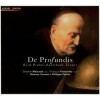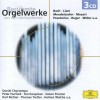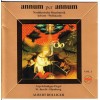Composers
Bruhns was born in Schwabstedt, a small settlement near Husum. He came from a family of musicians and composers. His grandfather, Paul (died 1655), worked as lutenist in Lübeck. His three sons all chose musical careers; Bruhns' father, also named Paul (1640–c. 1689), became organist at Schwabstedt, possibly after studying with Franz Tunder. Nicolaus was apparently a child prodigy: according to Ernst Ludwig Gerber, he could play the organ and compose competent works for keyboard and voice already at an early age. He probably received his first music lessons from his father.
At age sixteen, Bruhns, together with his younger brother Georg, was sent to Lübeck to live with his uncle Peter, who would teach Bruhns the violin and the viola da gamba. The two brothers also studied the organ and composition, Georg under Bernhard Olffen, organist of St. Aegidien, and Nicolaus under Dieterich Buxtehude. The latter, one of the best composers of his time, was so impressed with Bruhns' talents and progress that he considered him his best pupil and eventually recommended him for Copenhagen. There Bruhns worked as organist and violinist. On 29 March 1689 he competed for the position of organist of the Stadtkirche in Husum and was unanimously accepted. In a few months he was offered a position at Kiel, but declined when the authorities at Husum increased his salary. Bruhns remained in Husum until his untimely death in 1697, at the age of 31. His only son, Johan Paul, chose a career in theology. Bruhns was succeeded in Husum by his brother Georg.
Bruhns' surviving oeuvre is unfortunately small: only 12 vocal and 5 organ pieces are extant. The vocal works include four sacred concertos that established a new level of virtuosity in the genre, and three sacred madrigal cantatas that represent a direct link with the next century and the work of Johann Sebastian Bach. Although the instrumental writing in most of these works suggests that Bruhns could only rely on musicians of average skill, there are movements, such as the opening sonatina of the solo cantata Mein Herz ist bereit, that feature highly developed, virtuosic textures. Bruhns almost certainly wrote chamber music, which may have been of the same high quality, but none of these works survive.
The organ works comprise four praeludia and a chorale fantasia, Nun Komm der Heiden Heiland. The most significant of these pieces is the larger of the two E minor praeludia, which is usually cited as one of the greatest works of the North German organ tradition. Although Johann Sebastian Bach's son Carl Philipp Emanuel Bach claimed that his father admired and studied Bruhns' work, no direct influence has been traced by scholars.
Recently Added
Biography
Bruhns was born in Schwabstedt, a small settlement near Husum. He came from a family of musicians and composers. His grandfather, Paul (died 1655), worked as lutenist in Lübeck. His three sons all chose musical careers; Bruhns' father, also named Paul (1640–c. 1689), became organist at Schwabstedt, possibly after studying with Franz Tunder. Nicolaus was apparently a child prodigy: according to Ernst Ludwig Gerber, he could play the organ and compose competent works for keyboard and voice already at an early age. He probably received his first music lessons from his father.
At age sixteen, Bruhns, together with his younger brother Georg, was sent to Lübeck to live with his uncle Peter, who would teach Bruhns the violin and the viola da gamba. The two brothers also studied the organ and composition, Georg under Bernhard Olffen, organist of St. Aegidien, and Nicolaus under Dieterich Buxtehude. The latter, one of the best composers of his time, was so impressed with Bruhns' talents and progress that he considered him his best pupil and eventually recommended him for Copenhagen. There Bruhns worked as organist and violinist. On 29 March 1689 he competed for the position of organist of the Stadtkirche in Husum and was unanimously accepted. In a few months he was offered a position at Kiel, but declined when the authorities at Husum increased his salary. Bruhns remained in Husum until his untimely death in 1697, at the age of 31. His only son, Johan Paul, chose a career in theology. Bruhns was succeeded in Husum by his brother Georg.
Bruhns' surviving oeuvre is unfortunately small: only 12 vocal and 5 organ pieces are extant. The vocal works include four sacred concertos that established a new level of virtuosity in the genre, and three sacred madrigal cantatas that represent a direct link with the next century and the work of Johann Sebastian Bach. Although the instrumental writing in most of these works suggests that Bruhns could only rely on musicians of average skill, there are movements, such as the opening sonatina of the solo cantata Mein Herz ist bereit, that feature highly developed, virtuosic textures. Bruhns almost certainly wrote chamber music, which may have been of the same high quality, but none of these works survive.
The organ works comprise four praeludia and a chorale fantasia, Nun Komm der Heiden Heiland. The most significant of these pieces is the larger of the two E minor praeludia, which is usually cited as one of the greatest works of the North German organ tradition. Although Johann Sebastian Bach's son Carl Philipp Emanuel Bach claimed that his father admired and studied Bruhns' work, no direct influence has been traced by scholars.


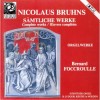
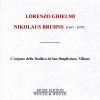
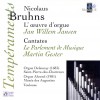


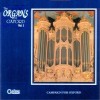
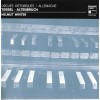
![12 Organs of Edinburgh [CD 2 of 2]](http://static.classicalm.com/repository/collection-cover/small/767-img1339685109419951.jpg)
![Great European Organs. 12-John Scott Whiteley [St Bavo Haarlem]](http://static.classicalm.com/repository/collection-cover/small/863-img1340965531370432.jpg)
![Great European Organs. 33-Matthias Eisenberg [St Goergenkirche Rotha]](http://static.classicalm.com/repository/collection-cover/small/905-img1341488507625287.jpg)
![Het Historische Orgel in Nederland [CD 2 of 20]](http://static.classicalm.com/repository/collection-cover/small/983-img1343144263780366.jpg)
